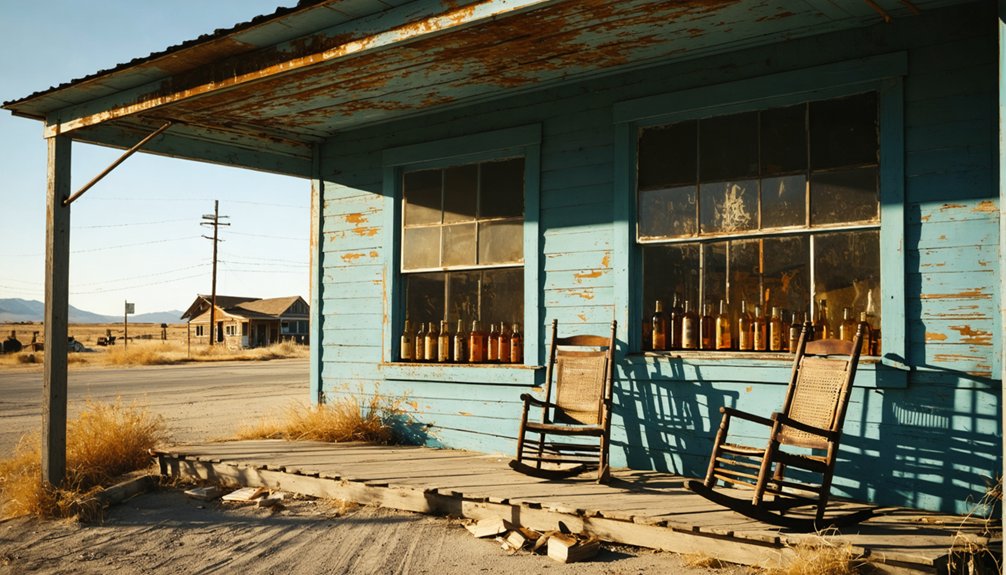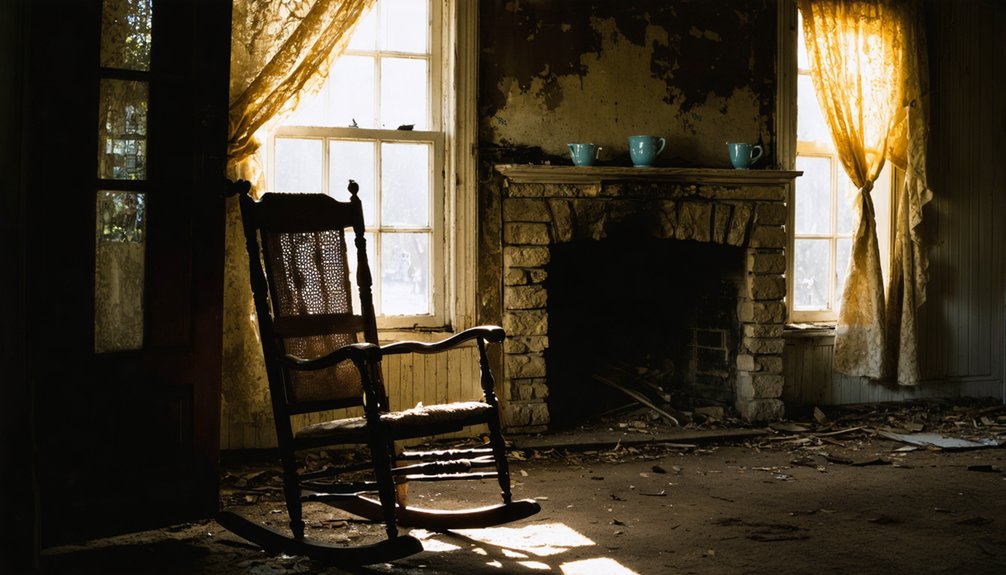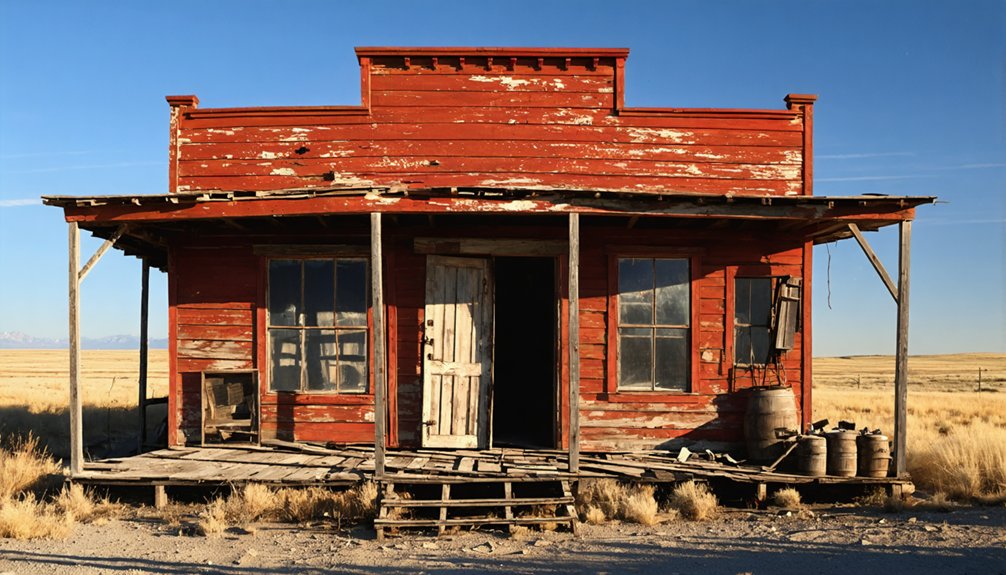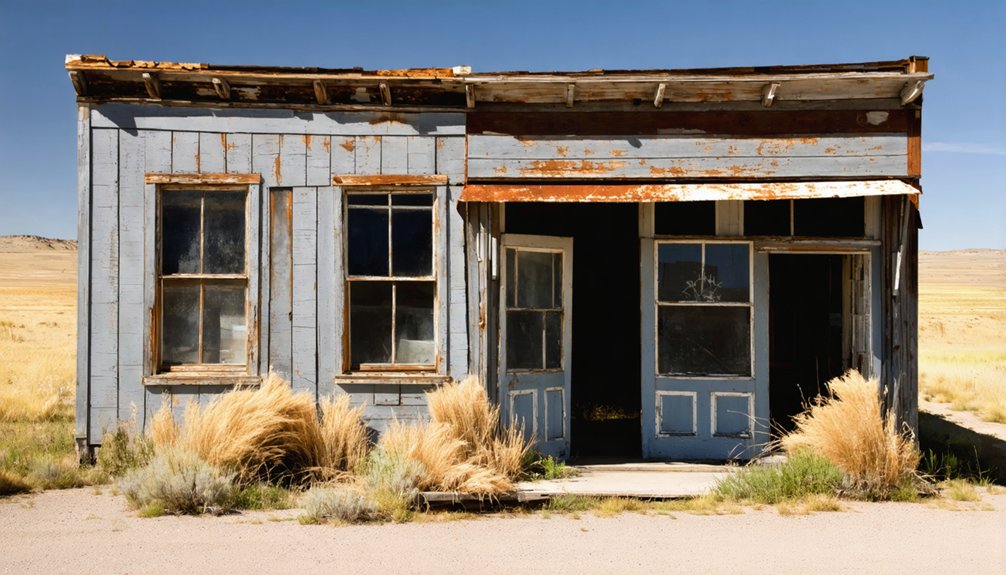You’ll find Saratoga tucked away in South Dakota’s Black Hills, where it emerged during the 1876 gold rush. The town flourished through mining and lumber operations, with its population reaching about 100 residents at its peak. By 1887, it boasted a post office and thriving commercial district, while miners reached depths of 370 feet by 1902. Today, weathered structures and mining remnants dot the landscape, preserving stories of this once-prosperous frontier community.
Key Takeaways
- Saratoga began as a mining settlement after the 1874 Black Hills gold discovery, growing into a prosperous community by 1887.
- The town featured a commercial district with a post office, saloon, and mining facilities during its peak operations.
- Economic decline began in the early 1950s with the sawmill’s closure and isolation from dismantled railroad lines.
- Weathered structures, including a grain elevator and mining equipment storage facilities, remain as evidence of the former community.
- Visitors can explore the ghost town’s remains during summer months but must respect private property and practice safety around unstable structures.
The Birth of a Black Hills Settlement
While the Black Hills had been home to Indigenous peoples for thousands of years, the discovery of gold in 1874 during Custer’s expedition transformed the region’s fate. The rush began in earnest after Fred and Moses Manuel’s rich gold strikes in 1876, leading to rapid settlement throughout the Black Hills despite treaty violations of Sioux territory. The Deadwood Formation provided the rich deposits of gold that drew prospectors to the area.
You’ll find Saratoga’s origins tied directly to this period of explosive growth, when miners and entrepreneurs pushed into the region following the government’s seizure of *Ȟe Sápa* through the 1877 Manypenny Agreement. The Supreme Court would later describe these U.S. dealings with the Sioux as deeply dishonorable actions.
Early settlers established the typical infrastructure of a mining boomtown – saloons, gambling halls, and basic services – while displacing the Lakota Sioux who’d controlled the area since the 18th century.
Life in Early Saratoga
As Saratoga took shape in the Black Hills, settlers carved out a modest existence from the dense forest landscape. You’d find families living in log cabins, working their fields with rifles at the ready, facing both wildlife threats and uncertain relations with Native American tribes. The community dynamics centered around survival and mutual support. Like the pioneers of early Saratoga County, the settlers faced hardship, toil, and risks from the wilderness. The discovery of gold in 1874 had drawn many fortune-seekers to the Black Hills region.
Pioneer families forged a tenuous existence in Saratoga’s wilderness, banding together against natural dangers and cultural tensions.
Early challenges of frontier life shaped daily routines:
- You’d plow small crop fields between charred stumps, growing just enough to sustain your family.
- You’d gather with neighbors at the schoolhouse for important decisions and community naming sessions.
- You’d trade occasionally with nearby settlements while maintaining a largely self-reliant lifestyle.
The grid-pattern streets, named after American heroes like Washington and Webster, reflected the settlers’ hopes of building a permanent home in this wild territory.
Mining and Railroad Glory Days
During the early 1900s, mining operations transformed Saratoga’s quiet frontier into an industrious hub of activity, despite never achieving the success of larger Black Hills mines.
You’d have found miners digging deep into the earth, reaching depths of 370 feet by 1902, using evolving mining techniques from basic hand operations to advanced cyanidation processes that could recover up to 94% of available gold.
Railroad expansion proved essential to Saratoga’s development, with compressed air locomotives replacing horse-drawn carts underground by 1901.
The rails connected the area’s mines to regional hubs and refineries, enabling efficient transport of ore and supplies.
Safety protocols required miners to wear protective helmets and lamps while working underground.
While the Glover Gold Mining Company never realized commercial success at their Saratoga claim, the mining infrastructure and railroad networks they established marked a brief but significant period in the town’s history.
Like many Black Hills mining operations, the town emerged after Custer’s 1874 expedition revealed the region’s rich gold deposits.
Notable Buildings and Infrastructure
You’ll find remnants of Saratoga’s once-bustling commercial district in the weathered post office building and adjacent saloon, both constructed with local materials in the early 1900s.
Mining equipment storage facilities, while largely deteriorated, still stand as evidence of the town’s industrial heritage, with their thick stone foundations visible among the overgrowth. Like other sites in disrepair, these abandoned structures showcase the gradual decline typical of South Dakota ghost towns. The decaying wooden grain elevator remains a prominent landmark, much like the one found in Okaton’s landscape.
These structures, though abandoned for decades, provide valuable insights into the daily operations of this former mining community.
Post Office And Saloon
Two of Saratoga’s most essential buildings were its post office and saloon, both serving as significant community hubs in the late 19th to early 20th centuries.
Like many South Dakota frontier towns, you’d find post office operations housed in multi-use buildings, while the saloon culture thrived alongside the town’s development.
- The post office adapted to changing needs, moving between various locations including general stores and private homes, reflecting the town’s economic shifts.
- The saloon served as more than just a drinking establishment – it functioned as a social center where miners and railroad workers gathered after long work days.
- Both structures played important economic roles until the town’s decline, with the saloon attracting transient workers near the railroad depot while the post office facilitated essential communication and commerce.
The town’s population dwindled as mining challenges led to abandonment, similar to the fate of Hayward and Castleton.
Following patterns seen in towns like Detroit, these buildings faced uncertain futures as economic hardships led many residents to relocate structures to neighboring communities.
Mining Equipment Storage
While many of Saratoga’s structures have succumbed to time, the mining equipment storage facilities stand out as particularly well-engineered remnants of the town’s industrial past.
You’ll find substantial stone foundations and timber-built structures that once protected valuable mining machinery from the harsh Black Hills weather.
The storage facilities were strategically positioned near mine shafts and processing areas, maximizing operational efficiency.
Storage techniques included covered sheds for delicate tools and dedicated pump houses for water equipment.
You can still spot fragments of iron framework and remnants of wooden roofing that sheltered everything from ore carts to stamp mill components.
The buildings weren’t just storage spaces – they doubled as workshops where miners repaired their equipment, making them essential hubs of daily mining operations.
Daily Life and Community Spirit

As small towns often did in early South Dakota, Saratoga built its community life around a central chapel that served as both a spiritual center and social gathering place.
You’d find the town’s spirit strongest in its shared experiences, from daily work at the sawmill to community gatherings during seasonal celebrations. The close-knit population of about 100 residents maintained social traditions through:
- Railroad and sawmill work schedules that shaped daily routines
- Multi-purpose buildings hosting informal social activities
- Mutual support during hardships like the 1919 influenza pandemic
Despite challenges from flooding and eventual industrial decline, Saratoga’s residents showed remarkable resilience.
Through floods and fading industry, the people of Saratoga demonstrated an unwavering spirit that defined their community’s character.
They adapted to changing times, even transforming old railroad grades into recreational trails, proving that community bonds remained strong through times of adversity.
Economic Rise and Decline
The economic story of Saratoga began with the late 19th-century mining discoveries in the Black Hills region. You’d find the town thriving as a hub for miners, with a post office established by 1887 and railroad connections facilitating trade.
The town’s prosperity relied heavily on lumber production and cattle shipments, supporting the region’s mining operations.
However, economic fluctuations hit Saratoga hard. The sawmill, once a major employer, closed in the early 1950s, while industrial challenges mounted as resources became depleted.
You’ll recognize a familiar pattern of boom-and-bust cycles that plagued many Western towns. The dismantling of railroad lines isolated Saratoga, cutting off essential transportation routes.
These factors, combined with mechanization and changing economic patterns, ultimately led to the town’s abandonment, leaving behind only scattered remnants of its once-bustling past.
The Last Residents’ Stories

Living in Saratoga during its final years meant facing profound isolation and mounting challenges. The last residents held onto their ancestral homes, managing daily life through remarkable resourcefulness and determination.
You’ll find their personal stories woven into the fabric of this ghost town’s history, revealing tales of resilience against the odds.
- They maintained strong family connections to the land, preserving memories of the once-thriving community.
- They relied on nearby towns for basic services while handling most needs independently.
- They became unofficial caretakers, protecting the town’s remaining structures and cultural heritage.
The isolation took its toll as infrastructure crumbled around them, yet these final inhabitants became living historians, keeping Saratoga’s legacy alive through their experiences and determination to preserve its story for future generations.
Preserving the Past
Present-day efforts to preserve Saratoga’s legacy build upon the foundations laid by its final inhabitants.
While you won’t find the town listed on national or state historic registers, South Dakota’s ghost town preservation initiatives offer hope for sites like Saratoga. The State Historic Preservation Office maintains inventories of these vanished communities, though physical evidence often consists of mere foundations and scattered remnants.
You’ll find that heritage tourism development faces challenges here, as Saratoga lacks the visible structures that typically attract preservation funding.
However, the SHPO’s educational programs and archaeological surveys help document what remains. Local government engagement through technical assistance and potential Certified Local Government status could boost preservation efforts.
Your support of oral history collection proves especially essential, as memories and stories often outlast the physical town itself.
Exploring the Ghost Town Today

Today, visiting Saratoga’s ghost town requires careful planning and a reliable vehicle suited for rural Black Hills terrain. You’ll find weathered mining structures and foundations scattered across the landscape, offering compelling opportunities for ghost town exploration and photography.
For the best experience during your visit:
- Plan your trip during summer or early fall when weather conditions are most favorable and roads are passable.
- Bring appropriate gear and safety equipment, as structures are unstable and terrain can be challenging.
- Visit during daylight hours for ideal photography tips and safer navigation of the site.
The site’s authentic abandonment atmosphere and minimal modern intrusion create striking photo opportunities against the natural Black Hills backdrop.
You’re free to explore and photograph the remnants, though remember to respect any private property boundaries.
Historical Legacy in Modern Times
Although Saratoga now stands silent amid the Black Hills landscape, its historical significance continues to shape South Dakota’s cultural heritage.
You’ll find its legacy preserved through archival photographs, maps, and written accounts that tell the story of this once-bustling mining town.
The town’s cultural impact extends beyond its physical remains, as it enriches historical narratives about the Black Hills’ mining era.
Saratoga’s legacy transcends its abandoned structures, weaving rich threads into the tapestry of Black Hills mining history.
You can explore these stories through educational programs and interpretive tours that highlight Saratoga’s role in the region’s development.
Local historians and ghost town enthusiasts keep the town’s memory alive through research initiatives and documentation efforts.
While less visited than Deadwood, Saratoga draws heritage tourists seeking authentic connections to the American West’s mining past, contributing to the region’s broader historical tourism appeal.
Frequently Asked Questions
Are There Any Reported Paranormal Activities or Ghost Sightings in Saratoga?
Like a blank smartphone screen, you won’t find ghost encounters or spectral sightings here. Historical records and paranormal databases don’t document any supernatural activity, unlike nearby Deadwood’s well-known haunted locations.
What Precautions Should Visitors Take When Exploring the Abandoned Buildings?
You’ll need safety gear including sturdy boots and a helmet since building stability is questionable. Don’t enter alone, watch for holes, and stay alert for wildlife and sharp debris.
Which Artifacts From Saratoga Can Be Found in Local Museums?
You won’t find confirmed Saratoga artifacts in local museum displays, as there’s no documented collection from this ghost town. Even South Dakota’s major museums don’t currently showcase items from Saratoga.
Were There Any Major Crimes or Notable Outlaws Associated With Saratoga?
While you might expect wild outlaw legends from a Black Hills settlement, historical records don’t show any major crimes or notorious outlaws connected to Saratoga’s history during its brief existence.
What Native American Tribes Originally Inhabited the Area Before Saratoga’s Establishment?
You’ll find the Sioux Nation, particularly the Lakota, dominated this area after their historical migrations from the Great Lakes, while earlier tribes of tribal significance included the Mandan and Arikara.
References
- https://usghostadventures.com/deadwood-ghost-tour/
- https://www.deadwood.com/history/
- https://www.powderhouselodge.com/black-hills-attractions/fun-attractions/ghost-towns-of-western-south-dakota/
- https://www.sdhspress.com/journal/south-dakota-history-2-2/some-black-hills-ghost-towns-and-their-origins/vol-02-no-2-some-black-hills-ghost-towns-and-their-origins.pdf
- https://www.sdpb.org/rural-life-and-history/2023-08-21/some-black-hills-ghost-towns-and-their-origins
- https://www.youtube.com/watch?v=_0WNYsFLSLA
- https://en.wikipedia.org/wiki/List_of_ghost_towns_in_South_Dakota
- https://www.1880town.com
- https://en.wikipedia.org/wiki/Seizure_of_the_Black_Hills
- https://en.wikipedia.org/wiki/Black_Hills



